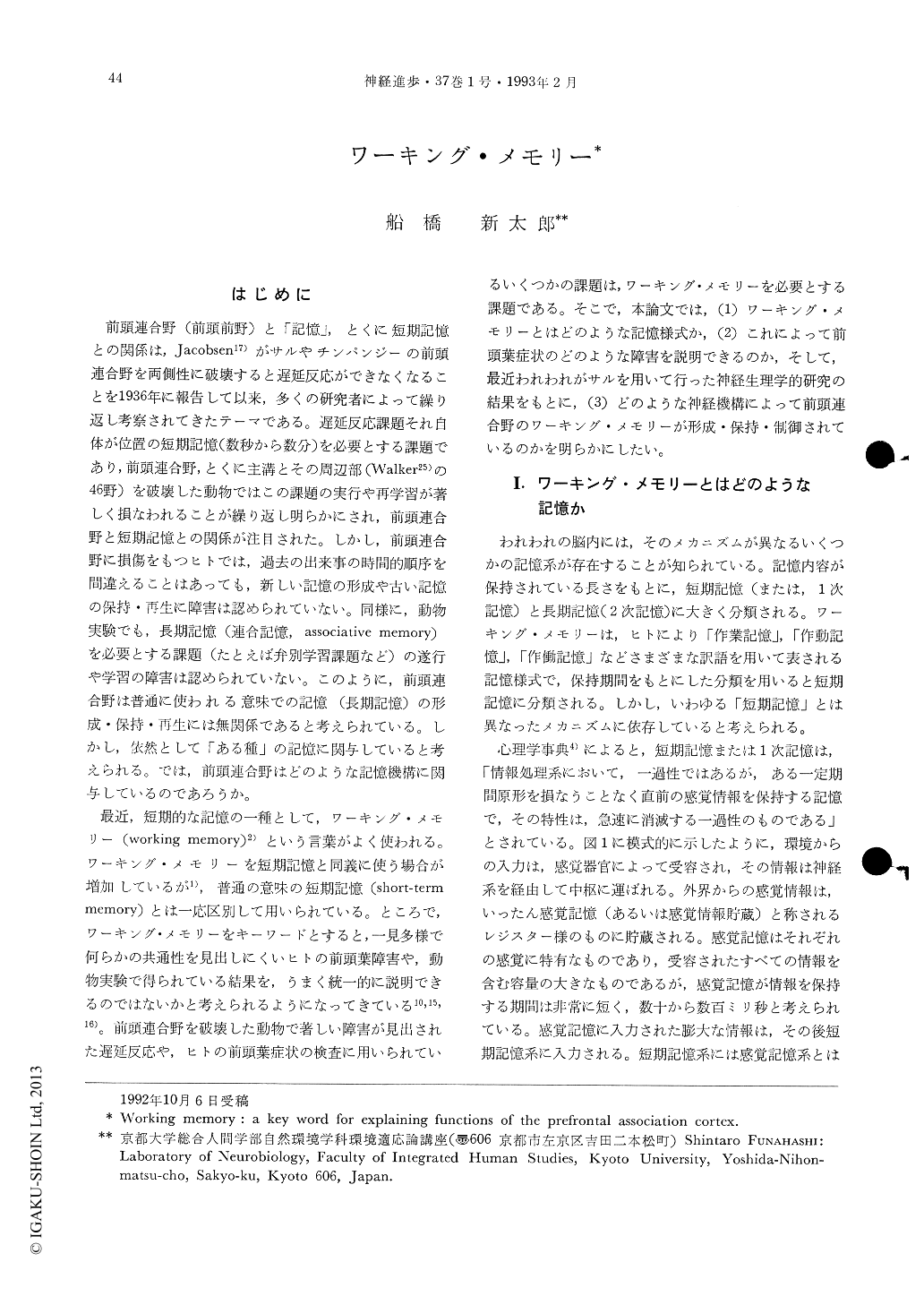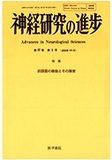Japanese
English
- 有料閲覧
- Abstract 文献概要
- 1ページ目 Look Inside
はじめに
前頭連合野(前頭前野)と「記憶」,とくに短期記憶との関係は,Jacobsen17)がサルやチンパンジーの前頭連合野を両側性に破壊すると遅延反応ができなくなることを1936年に報告して以来,多くの研究者によって繰り返し考察されてきたテーマである。遅延反応課題それ自体が位置の短期記憶(数秒から数分)を必要とする課題であり,前頭連合野,とくに主溝とその周辺部(Walker25)の46野)を破壊した動物ではこの課題の実行や再学習が著しく損なわれることが繰り返し明らかにされ,前頭連合野と短期記憶との関係が注目された。しかし,前頭連合野に損傷をもつヒトでは,過去の出来事の時間的順序を間違えることはあっても,新しい記憶の形成や古い記憶の保持・再生に障害は認められていない。同様に,動物実験でも,長期記憶(連合記憶,associative memory)を必要とする課題(たとえば弁別学習課題など)の遂行や学習の障害は認められていない。このように,前頭連合野は普通に使われる意味での記憶(長期記憶)の形成・保持・再生には無関係であると考えられている。しかし,依然として「ある種」の記憶に関与していると考えられる。では,前頭連合野はどのような記憶機構に関与しているのであろうか。
最近,短期的な記憶の一種として,ワーキング・メモリー(working memory)2)という言葉がよく使われる。ワーキング・メモリーを短期記憶と同義に使う場合が増加しているが1),普通の意味の短期記憶(short-term memory)とは一応区別して用いられている。ところで,ワーキング・メモリーをキーワードとすると,一見多様で何らかの共通性を見出しにくいヒトの前頭葉障害や,動物実験で得られている結果を,うまく統一的に説明できるのではないかと考えられるようになってきている10,15,16)。前頭連合野を破壊した動物で箸しい障害が見出された遅延反応や,ヒトの前頭葉症状の検査に用いられているいくつかの課題は,ワーキング・メモリーを必要とする課題である。そこで,本論文では,(1)ワーキング・メモリーとはどのような記憶様式か,(2)これによって前頭葉症状のどのような障害を説明できるのか,そして,最近われわれがサルを用いて行った神経生理学的研究の結果をもとに,(3)どのような神経機構によって前頭連合野のワーキング・メモリーが形成・保持・制御されているのかを明らかにしたい。
The prefrontal cortex has been known to participate in memory functions, especially short-term or transient memory. This was supported by many lesion studies as well as neurophysiological experiments. Recently, a term “working memory” is used widely in memory studies. The working memory is classified as a type of short-term memory. However, the working memory is different from ordinary “short-term memory” in that, in the working memory, the information necessary for a particular behavior or task is actively stored until the behavior or task is done. The key features of working memory are an active storage mechanism of particular information during necessary period and a reset mechanism after the information becomes unnecessary. Interestingly, many tests or tasks that only patients with dorsolateral frontal damage and monkeys with dorsolateral prefrontal lesions fail to perform correctly require working memory mechanisms. The active storage of cue information and effective resetting or switching of that information are necessary in all these tests, such as, delayed-response task, delayed matching-to-sample task, and Wisconsin Card Sorting Test. This suggests that the variety of deficits observed in frontal patients and frontal monkeys could be explained uniformly by using “working memory” as a key function of the prefrontal cortex. The importance of working memory as a function of the prefrontal cortex is supported by our recent neurophysiological experiments used an oculomotor version of the delayed-response task. Our results showed neuronal mechanisms in the prefrontal cortex for active storage of spatial information and for reset mechanisms of such information. Working memory has been known to be important basic processes for thinking, inferring, and comprehending. Destroying the prefrontal cortex causes destruction of working memory processes, hence causes disintegrated thought and inference. This may cause loss of planning quality, volition, positiveness, etc., that are listed as typical symptoms of prefrontal patients.

Copyright © 1993, Igaku-Shoin Ltd. All rights reserved.


